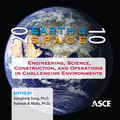Overcoming the Hurdles of Incorporating In Situ Resource Utilization (IRSU) into Human Lunar Exploration
Publication: Earth and Space 2010: Engineering, Science, Construction, and Operations in Challenging Environments
Abstract
The NASA Vision for Space Exploration released in February, 2004 promoted achieving four major goals and objectives: i) implementing a sustained and affordable human and robotic program, ii) extending the human presence across the solar system starting with returning to the Moon by 2020, iii) developing innovative technologies and infrastructures for human space exploration, and iv) promoting international and commercial participationin space exploration. Fundamental to achieving these goals was the need to identify and map space resources, develop new technologies to harness the Moon's and Mars' abundant resources, and develop reusable planetary landers, launch systems, and propellant depots. The ability to extract and use space resources to create products and services for propulsion, power, crew protection, and planetary surface infrastructure, know as In-Situ Resource Utilization (ISRU), is a completely new approach to human space exploration. In December, 2006 NASA released the first Lunar Architecture Team study which recognized both the benefits of incorporating ISRU as well as the uncertainty and risk associated with ISRU since no system had ever been operated in space, let alone on the ground at the time. The study also recognized that technology, design, and operational decisions for propulsion, power, and life support systems can be drastically different if ISRU capabilities are considered. The solution proposed was to establish a lunar architecture flexible enough to accommodate ISRU products and services when available, but not to rely on ISRU's benefits until it had been adequately proven. Before 2004, only small scale ISRU technology and process proof-of-concept laboratory experiments had ever been performed to provide confidence in the concept of ISRU. For ISRU to be successfully incorporated into human lunar exploration, two hurdles need to be overcome: 1) demonstrate that ISRU capabilities are possible at a scale, mass, power, and reliability relevant to future mission needs, and 2) demonstrate the critical interfaces and interconnections between ISRU systems and products with other lunar surface and transportation system elements so that technology selections and design decisions can be made across the lunar architecture to take advantage of the benefits of ISRU versus the approach to date which emphasizes delivering everything from Earth and optimizing the performance of each individual element. Through funding, partnership, and coordination between NASA, industry, academia, and other government space agencies such as the Canadian Space Agency, since 2005 a program has been underway to both develop relevant scale ISRU technologies and systems as well as to demonstrate the interaction and interconnection of ISRU with other lunar surface systems. This effort has culminated in two recent ISRU analog field test campaigns performed on Mauna Kea, on the Big Island of Hawaii in November 2008 and February 2010, involving resource prospecting, oxygen extraction from regolith, site preparation, and ISRU product storage and utilization. This paper will provide an overview of the ISRU technologies and systems developed for the analog field tests, as well as the accomplishments and lessons-learned. The paper will also present options for follow-on activities to further promote lunar surface system integration and partnerships with ISRU.
Get full access to this chapter
View all available purchase options and get full access to this chapter.
Information & Authors
Information
Published In
Copyright
© 2010 American Society of Civil Engineers.
History
Published online: Apr 26, 2012
Authors
Metrics & Citations
Metrics
Citations
Download citation
If you have the appropriate software installed, you can download article citation data to the citation manager of your choice. Simply select your manager software from the list below and click Download.
